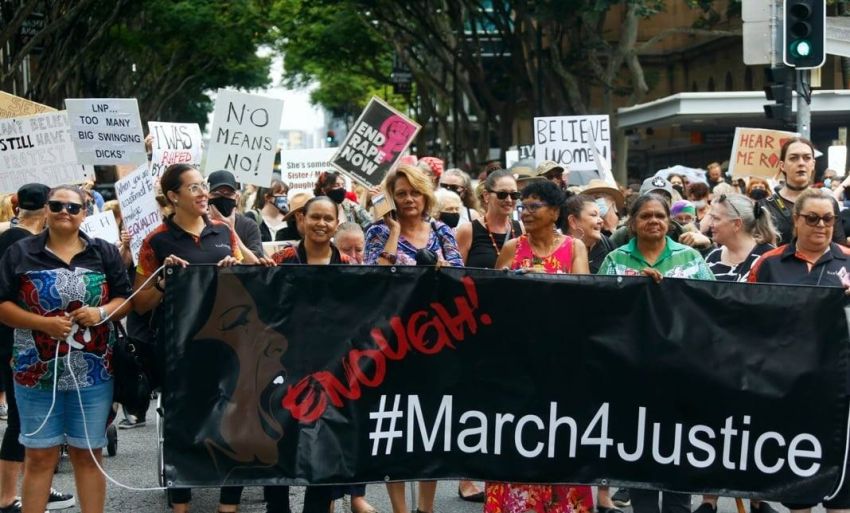
Grace Tame and Brittany Higgins were widely praised for using their National Press Club addresses in early February to highlight the hypocrisy of politicians paying lip-service to sexual violence in the workplace.
Both called for structural change, and gave some tips on what to do. Tame was applauded for her reply to one reporter’s question with: “I’m not interested in words anymore. I want to see action”.
Why is it so hard to stop sexual harassment and gendered violence? Why are women so often silenced, or ignored, when they speak out about rape and sexual abuse?
It has a lot to do with those in charge not accepting, or believing, that these crimes are systemic.
Consider the fact that Kate Jenkins, the Sex Discrimination Commissioner, released the Respect@Work National Inquiry into Sexual Harassment in Australian Workplaces two years ago and it was only tabled a year later. Worse, almost none of the 55 recommendations have been implemented.
The Sex Discrimination Act 1984 prohibited sexual harassment at work but, in practice, Jenkins said, “the rate of change has been disappointingly slow”. Australia, she said, now “lags behind other countries in preventing and responding to sexual harassment”.
Jenkins said the Australian Human Rights Commission’s Fourth National Survey on Sexual Harassment in Australian workplaces (2018) revealed the pervasive nature of sexual harassment in workplaces: “One in three people experienced sexual harassment at work in the past five years.” For First Nations women, and those with a disability, the rate is higher.
Women’s inequality is institutionalised under capitalism because the system requires women to maintain the family unit: by taking care of housework, childcare and nursing the sick and elderly.
This role is vital — but unpaid and undervalued. The system would come to a grinding halt without it. The Victorian government estimated in 2018 that unpaid work was worth $205 billion — half the state’s gross state product.
The gender pay gap in workplaces is another example of structural sexism. It was at a shocking 22.8%, according to the latest Gender Equality scorecard published on February 11 by the Workplace Gender Equality Agency (WGEA). WGEA found that across all industries women were paid less than men — even in women-dominated professions such as childcare, aged care, cleaning, teaching and nursing, where women make up 60% of the workforce.
However, the gender pay gap also drives down all workers’ wages. At the same time, women are more likely to be in part-time, casual and precarious employment. According to WGEA, women comprise 57% of the casual workforce.
When inequality and the sexual violence used to maintain it are challenged, the powers that be can be pushed to pretend to do something — like the apology to those who have been harassed in federal parliament.
As Tame said to applause: “The federal government’s approach to social issues seems to consist of nothing but empty announcements, placatory platitudes, superficial last-minute acknowledgements, and carefully staged photo ops”.
When I asked an all-male group of construction workers in a health and safety course if they thought gendered violence was a health and safety issue, one shocked the class by describing a brutal sexual assault on two women labourers on a night shift.
He went to investigate, but the women were worried about being seen as “troublemakers” and losing their jobs. They did not want to go to the police. Management was called in, the perpetrators were sacked and no other action was taken.
Everyone in the class was appalled: why were the women so fearful? I explained that, typically, most women in most workplaces fear not being believed, or taken seriously. They fear having the crimes minimised, of not receiving redress, or being victimised.
The Fourth National Survey on Sexual Harassment in Australian Workplaces (2018) shows up this culture of silence: only 17% of those who reported being sexually harassed at work actually made a complaint.
Revealingly, 40% of workplace sexual harassment incidents were witnessed by at least one other person, but 69% of witnesses did not intervene. Even more disturbingly, almost one-in-five people who did report were labelled a troublemaker (19%), ostracised, victimised or ignored by colleagues (18%), or resigned (17%).
To end workplace sexual harassment, we have to go beyond the apologies and promises to do better. Women must have economic equality: their work must be valued. This would go a long way towards addressing sexism and sexual violence in the workplace.
In the immediate term, gendered violence in workplaces must be investigated promptly and appropriate forms of redress that suit the needs of victim/survivors must be made mandatory.
Union representatives and health and safety representatives should adopt a sensitive, non-gendered risk management strategy. Learning from the process and implementing reforms must be the default setting.
Actions speak louder than words.
[March4Justice is being organised across the country on February 27. Sue Bull is a health and safety teacher. She is standing for the Socialist Alliance in the federal seat of Corio in Victoria.]